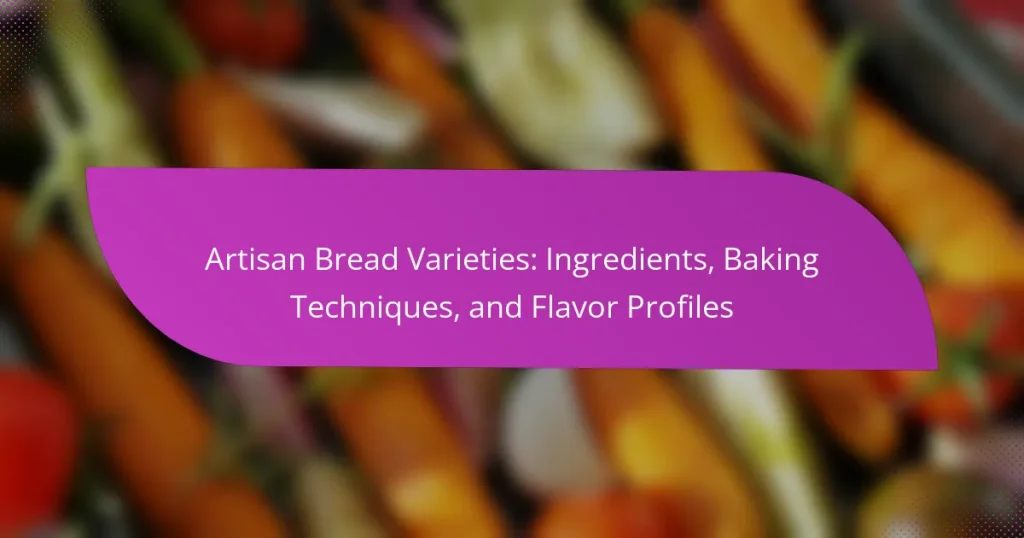Artisan bread varieties are traditionally crafted breads made with high-quality ingredients and specific baking techniques. This article covers the essential ingredients, including flour, water, salt, and yeast, that form the foundation of artisan breads. It also explores key baking techniques such as long fermentation, high-hydration dough, and steam baking that contribute to their unique textures and flavors. Additionally, the article highlights the diverse flavor profiles of various artisan breads, including sourdough, ciabatta, baguette, and focaccia, each characterized by distinct tastes influenced by their ingredients and preparation methods.

What are Artisan Bread Varieties?
Artisan bread varieties are types of bread made using traditional methods and high-quality ingredients. They often feature unique flavors and textures. Common varieties include sourdough, ciabatta, baguette, and focaccia. Each type has distinct characteristics. For example, sourdough is known for its tangy flavor due to natural fermentation. Ciabatta has a chewy crust and an open crumb structure. Baguettes are long, thin loaves with a crispy crust. Focaccia is a flatbread often topped with herbs and olive oil. These breads are typically handcrafted, emphasizing artisanal techniques. The use of natural leavening and slow fermentation enhances their taste and quality.
How do Artisan Bread Varieties differ from Commercial Bread?
Artisan bread varieties differ from commercial bread primarily in their ingredients and production methods. Artisan bread often uses high-quality, natural ingredients without preservatives. It typically includes simple components like flour, water, salt, and yeast. Commercial bread, in contrast, frequently contains additives and preservatives to enhance shelf life and texture.
Artisan bread is usually handcrafted, allowing for unique flavors and textures. This method often involves longer fermentation times, which develop complex flavors. Commercial bread is mass-produced, resulting in uniformity and quicker production times.
The baking techniques also differ significantly. Artisan bakers often use traditional methods, such as stone ovens, which contribute to a crusty exterior and chewy interior. Commercial bread is often baked in conveyor ovens, leading to a softer crust.
These differences result in distinct flavor profiles. Artisan bread tends to have richer, more varied flavors due to the fermentation process. Commercial bread generally has a milder taste, designed for broad consumer appeal.
What defines the characteristics of Artisan Bread?
Artisan bread is defined by its handcrafted nature and traditional baking methods. It typically uses high-quality ingredients, including flour, water, salt, and natural leavening agents. The dough is often fermented for extended periods, which enhances flavor and texture. Artisan bread is usually baked in small batches, allowing for greater attention to detail. The crust is often thick and crispy, while the interior is chewy and flavorful. Unique flavor profiles can arise from the use of specialty flours and additional ingredients like seeds or herbs. Artisan bread is also characterized by its irregular shape and open crumb structure, which distinguishes it from mass-produced bread.
Why are Artisan Bread Varieties considered unique?
Artisan bread varieties are considered unique due to their handcrafted nature and use of traditional methods. These breads often involve slow fermentation processes, which enhance flavor and texture. The ingredients used are typically high-quality, often organic, and may include local grains. Each artisan baker may have a signature technique or recipe that differentiates their bread. This can result in distinct flavor profiles and crust characteristics. The emphasis on small batches allows for greater attention to detail. According to the Bread Bakers Guild of America, artisan bread is defined by its quality and craftsmanship. This commitment to authenticity and tradition makes artisan breads unique within the broader category of bread.
What are the common types of Artisan Bread Varieties?
Common types of artisan bread varieties include sourdough, ciabatta, baguette, and focaccia. Sourdough is made using a natural fermentation process, which gives it a distinct tangy flavor. Ciabatta is known for its crispy crust and soft, airy interior. Baguette is characterized by its long shape and chewy texture. Focaccia is often topped with herbs and olive oil, offering a rich flavor profile. These breads are crafted using traditional methods, emphasizing quality ingredients and techniques. Each variety has unique attributes that cater to different tastes and culinary applications.
What are the key ingredients used in different Artisan Bread Varieties?
The key ingredients used in different artisan bread varieties include flour, water, salt, and yeast. Flour is the primary ingredient, providing the structure of the bread. Water activates the gluten and helps in the fermentation process. Salt enhances flavor and controls yeast activity. Yeast is responsible for the leavening, allowing the bread to rise. Some artisan breads may also include additional ingredients like sugar, fats, or seeds for flavor and texture. For example, sourdough uses a starter culture instead of commercial yeast. Whole grain breads utilize whole wheat flour for added nutrition. Each ingredient plays a vital role in the final product’s taste and texture.
How do regional influences shape Artisan Bread Varieties?
Regional influences shape artisan bread varieties through local ingredients, cultural traditions, and baking techniques. Different regions have unique climates that affect grain types, such as wheat or rye. For example, sourdough in San Francisco uses local wild yeast, creating a distinct flavor. Additionally, cultural practices dictate specific recipes and methods. In Italy, for instance, focaccia reflects local olive oil and herbs. Historical events, such as trade routes, also introduce diverse ingredients. Regions with dairy farming may incorporate buttermilk or cheese into their breads. Thus, regional influences create a rich tapestry of artisan bread varieties, each with unique characteristics.

What ingredients are essential for Artisan Bread?
Essential ingredients for artisan bread include flour, water, salt, and yeast. Flour provides the structure and gluten necessary for bread. Water hydrates the flour, activating gluten formation. Salt enhances flavor and regulates yeast activity. Yeast is crucial for fermentation and leavening, allowing the dough to rise. These four ingredients are fundamental in traditional artisan bread recipes. Their combination creates a unique texture and flavor profile characteristic of artisan breads.
How do different flours affect Artisan Bread?
Different flours significantly affect the texture, flavor, and structure of artisan bread. Bread flour, with a higher protein content, creates a chewier texture and better gluten development. Whole wheat flour adds a nutty flavor and denser crumb due to the bran and germ. Rye flour contributes a distinct taste and often results in a denser loaf because of its lower gluten formation. Gluten-free flours, such as almond or rice flour, yield a different texture and require additional binding agents for structure. Each flour type influences hydration levels, fermentation times, and ultimately the final bread product. The choice of flour is crucial for achieving desired characteristics in artisan bread.
What are the benefits of using whole grain versus white flour?
Whole grain flour offers more nutritional benefits compared to white flour. Whole grain flour retains the bran and germ of the grain. This results in higher fiber content, which aids digestion. Whole grain flour also contains more vitamins and minerals, such as B vitamins, iron, and magnesium. Studies show that whole grains can lower the risk of heart disease and diabetes. In contrast, white flour is heavily processed, stripping away these beneficial components. This processing reduces its nutritional value significantly. Whole grain flour can enhance the flavor and texture of artisan bread. It provides a nuttier taste and denser crumb structure.
How does the choice of yeast impact the final product?
The choice of yeast significantly impacts the final product in artisan bread. Different yeast strains contribute unique flavors and textures. For example, Saccharomyces cerevisiae is commonly used for its fast fermentation and reliable rise. This yeast produces a light and airy crumb in bread. In contrast, wild yeast, such as that found in sourdough, ferments slower and adds complex flavors. The fermentation duration and temperature also vary with yeast type, influencing the final taste and aroma. Furthermore, yeast selection affects the bread’s shelf life and crust characteristics. Thus, selecting the right yeast is crucial for achieving desired flavor profiles and textures in artisan bread.
What role do additional ingredients play in flavor and texture?
Additional ingredients play a crucial role in enhancing flavor and texture in artisan bread. These ingredients can include herbs, spices, seeds, and dairy products. Each ingredient contributes unique flavors, creating a more complex taste profile. For example, herbs like rosemary add aromatic qualities. Seeds such as sesame or poppy contribute crunch and visual appeal. Dairy ingredients, like butter or milk, can enrich the bread’s texture, making it softer and more moist. The combination of these additional ingredients can also influence the bread’s crust, making it either crispier or chewier. Overall, the strategic use of additional ingredients significantly elevates both the flavor and texture of artisan bread.
How do seeds, nuts, and fruits enhance Artisan Bread?
Seeds, nuts, and fruits enhance Artisan Bread by adding flavor, texture, and nutritional value. Seeds like sesame and poppy provide a nutty taste and crunch. Nuts such as walnuts and almonds contribute richness and healthy fats. Fruits like raisins and cranberries introduce sweetness and moisture. These ingredients also improve the bread’s overall aroma. The combination of flavors creates a more complex and enjoyable eating experience. Additionally, they offer health benefits, including increased fiber and antioxidants. Studies show that incorporating these elements can elevate the sensory qualities of bread.
What is the significance of hydration levels in dough preparation?
Hydration levels in dough preparation significantly affect the texture and flavor of the final product. Higher hydration results in a more open crumb structure and a chewier texture. Conversely, lower hydration yields a denser bread with a tighter crumb. Hydration levels also influence fermentation rates. More water can enhance yeast activity, leading to better rise and flavor development. Research indicates that doughs with 60-75% hydration are optimal for artisan bread. This range balances gluten development and moisture retention, crucial for achieving desired characteristics.

What baking techniques are used for Artisan Bread?
Artisan bread employs several key baking techniques. These techniques include long fermentation, which enhances flavor and texture. A high-hydration dough is often used, resulting in a moist crumb. Hand shaping is common, allowing for unique forms and crusts. Steam baking creates a crispy crust by generating steam in the oven. Scoring the dough before baking allows for controlled expansion. Additionally, using a preheated baking stone or Dutch oven improves heat retention and crust formation. These methods contribute to the distinctive quality of artisan bread.
How does the fermentation process influence the bread’s flavor?
The fermentation process significantly influences bread’s flavor. During fermentation, yeast and bacteria break down sugars in the dough. This process produces alcohol and organic acids, which contribute to the bread’s taste. The longer the fermentation, the more complex the flavors become. For instance, lactic acid bacteria create tangy notes in sourdough. Additionally, fermentation enhances the aroma of the bread. The Maillard reaction, which occurs during baking, also develops flavors that are influenced by fermentation. Ultimately, the fermentation process is crucial for achieving the desired flavor profile in artisan bread.
What are the different methods of fermentation used in Artisan Bread?
The different methods of fermentation used in artisan bread include direct fermentation, poolish, biga, and sourdough. Direct fermentation involves mixing flour, water, yeast, and salt, allowing the dough to rise directly. Poolish is a pre-ferment made with equal parts flour and water, along with a small amount of yeast, which enhances flavor and texture. Biga is an Italian pre-ferment with a stiff dough consistency, contributing to a complex flavor profile. Sourdough fermentation relies on naturally occurring wild yeast and bacteria, resulting in a tangy flavor and chewy texture. Each method influences the bread’s taste, texture, and overall quality.
Why is proofing important in the baking process?
Proofing is important in the baking process because it allows yeast to ferment and produce carbon dioxide. This gas creates air pockets in the dough, leading to a lighter and fluffier texture. During proofing, the dough also develops flavor and improves its structure. Proper proofing enhances the overall quality of the bread. Studies show that insufficient proofing can result in dense loaves. Conversely, over-proofing can lead to loss of structure. Therefore, timing and temperature are critical during this stage. Proper proofing significantly impacts the final product’s taste and texture.
What baking methods are commonly employed for Artisan Bread?
Commonly employed baking methods for artisan bread include steam baking, hearth baking, and no-knead techniques. Steam baking creates a moist environment, enhancing crust development. Hearth baking involves placing bread directly on a hot surface, promoting even cooking. No-knead techniques allow for longer fermentation, developing flavor and texture. These methods contribute to the unique characteristics of artisan bread. Steam baking is often used in professional bakeries to achieve a crisp crust. Hearth baking is traditional and preferred for its rustic appearance. No-knead techniques are popular among home bakers for their simplicity and effectiveness.
How does baking in a Dutch oven differ from using a traditional oven?
Baking in a Dutch oven differs from using a traditional oven primarily in heat retention and moisture control. A Dutch oven is a heavy, cast-iron pot with a lid that traps steam. This steam creates a humid environment, which helps to develop a crust on the bread. In contrast, a traditional oven lacks this steam retention, leading to a drier baking environment.
The enclosed space of a Dutch oven allows for even heat distribution. This results in more consistent baking and browning of the bread. Traditional ovens can have hot spots that may unevenly cook the bread.
Additionally, the high walls of a Dutch oven help to contain heat, allowing for a higher initial temperature. This can enhance oven spring, which is the rapid rise of bread during the first few minutes of baking. Traditional ovens may require additional equipment, such as a baking stone or steam tray, to achieve similar results.
Thus, the key differences lie in steam retention, heat distribution, and temperature control, all of which significantly impact the baking process and final bread quality.
What techniques can enhance crust development in Artisan Bread?
Techniques that enhance crust development in artisan bread include using steam during baking. Steam helps create a moist environment, allowing the bread to expand fully before the crust sets. Another technique is baking at a high temperature, typically between 450°F to 500°F. This high heat promotes Maillard reaction, leading to a deeper color and flavor in the crust. Additionally, using a preheated baking stone or steel can improve heat retention and distribution. Incorporating a longer fermentation process also contributes to crust development by enhancing flavor and texture. Finally, scoring the dough before baking allows for controlled expansion, promoting an even crust.

What are the flavor profiles of Artisan Bread Varieties?
Artisan bread varieties feature diverse flavor profiles that depend on ingredients and baking methods. Common flavors include nutty, sweet, tangy, and earthy notes. For example, sourdough bread has a distinct tanginess due to the fermentation process. Whole grain breads offer a robust, nutty flavor from the grains used. Rye bread presents a slightly sour and earthy taste, influenced by the rye flour. Focaccia is known for its olive oil richness and herb-infused flavors. Ciabatta has a mild flavor with a chewy texture, often enhanced by added ingredients like olives or sun-dried tomatoes. Each variety’s flavor profile is shaped by fermentation, ingredients, and baking techniques, making artisan breads unique and flavorful.
How do different ingredients contribute to flavor complexity?
Different ingredients contribute to flavor complexity by introducing unique taste profiles and aromatic compounds. For example, flour types vary in protein content, affecting gluten development and texture. Whole grain flours add nuttiness and depth, while white flours provide a milder flavor. Yeast strains also play a crucial role; some produce fruity esters, enhancing the bread’s aroma.
Additives like salt enhance flavor by balancing sweetness and bitterness. Sweeteners, such as honey or malt, introduce caramel notes that deepen the overall taste. Fats, like butter or olive oil, contribute richness and mouthfeel, further complicating flavor. Herbs and spices can add distinctive aromas and tastes, making each loaf unique.
Research indicates that fermentation time affects flavor; longer fermentation allows for more complex flavor development due to enzymatic activity. These interactions among ingredients create the intricate flavor profiles found in artisan breads.
What flavors can be expected from sourdough versus whole grain breads?
Sourdough bread typically has a tangy flavor due to the fermentation process. This tanginess results from lactic acid produced by wild yeast and bacteria. The crust is often crispy, while the inside is chewy and has a complex flavor profile. Whole grain bread, on the other hand, has a nuttier and slightly sweet flavor. This sweetness comes from the natural sugars in the whole grains. Whole grain bread often has a denser texture compared to sourdough. Both breads can have variations in flavor based on the specific grains used and the baking methods.
How do fermentation times affect the bread’s taste?
Fermentation times significantly affect bread’s taste. Longer fermentation enhances flavor complexity through the development of organic acids and alcohols. These compounds contribute to a more nuanced and tangy taste. Shorter fermentation yields milder flavors with less depth. Additionally, longer fermentation can improve the bread’s texture, leading to a more appealing mouthfeel. Research shows that sourdough bread, which undergoes extended fermentation, exhibits distinct taste characteristics compared to quick-rise breads. This is due to the increased activity of lactic acid bacteria during prolonged fermentation.
What are the most popular flavor combinations in Artisan Bread?
Popular flavor combinations in artisan bread include rosemary and sea salt, olive and garlic, and fig and walnut. These pairings enhance the bread’s taste and aroma. Rosemary and sea salt create a savory profile, often used in focaccia. Olive and garlic add a Mediterranean flair, commonly found in batard loaves. Fig and walnut contribute a sweet and nutty contrast, popular in whole grain breads. Other notable combinations are cheddar and chive, and sundried tomato with basil. These flavors cater to diverse palates and are frequently featured in artisan bakeries.
How do herbs and spices elevate the flavor of Artisan Bread?
Herbs and spices enhance the flavor of artisan bread by introducing aromatic and savory notes. These ingredients add complexity to the bread’s taste profile. Common herbs like rosemary and thyme contribute earthy flavors. Spices such as garlic powder or cumin offer warmth and depth. The infusion of these elements can create a more enjoyable eating experience. Additionally, they can complement the bread’s texture and crust. Research indicates that specific herbs and spices can increase sensory appeal. For example, a study found that adding herbs can elevate overall flavor perception in baked goods.
What seasonal ingredients can enhance Artisan Bread varieties?
Seasonal ingredients that can enhance artisan bread varieties include fresh herbs, fruits, and vegetables. For example, rosemary and thyme add aromatic flavors to bread. Seasonal fruits like apples or pumpkins can provide natural sweetness and moisture. Vegetables such as roasted garlic or sun-dried tomatoes contribute unique tastes and textures. Using these ingredients can elevate the bread’s flavor profile. Seasonal ingredients also reflect local harvests, promoting freshness. Incorporating them can lead to innovative and diverse artisan bread creations.
What tips can improve your Artisan Bread baking skills?
To improve your artisan bread baking skills, focus on precise measurements and quality ingredients. Use a kitchen scale for accuracy in flour and water ratios. Experiment with different types of flour, such as bread flour or whole wheat, to enhance flavor and texture. Hydration levels are crucial; a higher hydration dough can lead to better crumb structure. Allow for proper fermentation time, which develops flavor and strength in the dough. Use techniques like stretch and fold during bulk fermentation to build gluten structure. Maintain a consistent baking temperature for even cooking. Lastly, invest in a baking stone or steel to improve heat retention and crust development. These tips are supported by baking science, which emphasizes the importance of ingredient quality and technique in achieving desirable bread characteristics.
Artisan bread varieties are handcrafted breads made using traditional methods and high-quality ingredients, resulting in unique flavors and textures. This article explores the key characteristics of artisan breads, including common types like sourdough, ciabatta, baguette, and focaccia, as well as the essential ingredients and baking techniques that contribute to their distinct profiles. It also examines the impact of fermentation, hydration levels, and additional ingredients on flavor complexity, while highlighting popular flavor combinations and seasonal enhancements. Overall, the article provides a comprehensive overview of artisan bread, emphasizing its craftsmanship and the factors that define its quality.




